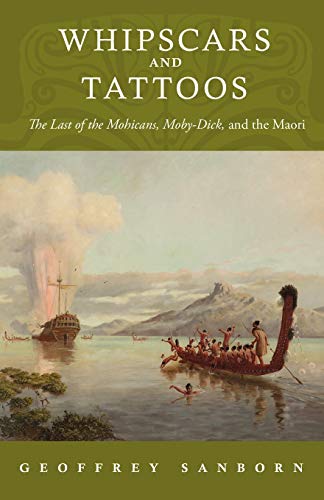Items related to Whipscars and Tattoos: The Last Of The Mohicans, Moby-Dick,...

At the same time, this isn't a simple source study nor an act of explanatory historical recovery. The conception of the Maori is sophisticated and paradoxical, a portrait of violent but nonetheless idealized masculinity in which dignity depends on the existence of fiercely defiant pride. This lens allows Sanborn to present a radically different view of these fictional characters as well as underscoring the imaginative projection that went into reporting on the Maori themselves. Magua is no longer a stereotypical "bad Indian" or "ignoble savage," but rather a non-white "gentleman," an argument that supports Sanborn's contention that throughout his career Cooper prioritizes status equivalence over racial difference. Queequeg is similarly re-imagined, a move that allows Sanborn to explicate scenes in Moby-Dick that are often dodged by other critics because they do not fit with the standard interpretations of the character. The study as a whole provides a vivid example of the fascinating interplay between fiction and non-fiction in the nineteenth century.
"synopsis" may belong to another edition of this title.
Who would have thought that the lives of two Maori from New Zealand would resonate so powerfully in two of the most celebrated masterpieces of American literature? Sanborn, with his extraordinary eye for the telling detail, has written an illuminating and compellingly original study of the transnational cross-cultural frontier. (Alex Calder, The Writing of New Zealand)
Geoffrey Sanborn's Whipscars and Tattoos illuminates everything it touches in new and startling ways, from its harrowingly memorable portrait of the Maori to its brilliantly reorienting readings of two of America's most canonical novelists, and in doing so, provides an exhilarating example of what American Studies can do, and be. (Jim Shepard, author of Like You'd Understand, Anyway)
Fascinating...Specialists will appreciate Sanborn's detailed notes, and less experienced readers will have no difficulty following his clear prose. Highly recommended. (Choice)
Adds substantially to our knowledge about Melville's possible reading and sources. (Resources for American Literary Study)
Geoffrey Sanborn is Professor of English at Amherst College. He is the author of Sign of the Cannibal: Melville and the Making of a Postcolonial Reader and the coeditor, with Samuel Otter, of Melville and Aesthetics.
"About this title" may belong to another edition of this title.
- PublisherOxford University Press, Usa
- Publication date2013
- ISBN 10 0199985766
- ISBN 13 9780199985760
- BindingPaperback
- Number of pages208
Buy New
Learn more about this copy
Shipping:
£ 3.20
Within U.S.A.
Top Search Results from the AbeBooks Marketplace
Whipscars and Tattoos: The Last of the Mohicans, Moby-Dick, and the Maori
Book Description Paperback. Condition: new. New. Fast Shipping and good customer service. Seller Inventory # Holz_New_0199985766
Whipscars and Tattoos: The Last of the Mohicans, Moby-Dick, and the Maori
Book Description Paperback. Condition: new. New. Seller Inventory # Wizard0199985766
Whipscars and Tattoos: The Last of the Mohicans, Moby-Dick, and the Maori
Book Description Condition: new. Seller Inventory # FrontCover0199985766
Whipscars and Tattoos: The Last of the Mohicans, Moby-Dick, and the Maori
Book Description Paperback. Condition: new. New Copy. Customer Service Guaranteed. Seller Inventory # think0199985766
Whipscars and Tattoos: The Last of the Mohicans; Moby-Dick; and the Maori
Book Description Condition: New. PRINT ON DEMAND Book; New; Fast Shipping from the UK. No. book. Seller Inventory # ria9780199985760_lsuk
Whipscars and Tattoos: The Last of the Mohicans, Moby-Dick, and the Maori
Book Description PF. Condition: New. Seller Inventory # 6666-IUK-9780199985760
Whipscars and Tattoos: The Last of the Mohicans, Moby-Dick, and the Maori
Book Description Paperback / softback. Condition: New. This item is printed on demand. New copy - Usually dispatched within 5-9 working days. Seller Inventory # C9780199985760
Whipscars and Tattoos: The Last of the Mohicans, Moby-Dick, and the Maori
Book Description Condition: New. Seller Inventory # ABLIING23Feb2215580059421
Whipscars and Tattoos (Paperback)
Book Description Paperback. Condition: new. Paperback. In this original study, Geoffrey Sanborn presents a fresh interpretation of the villanous Magua in James Fenimore Cooper's The Last of the Mohicans (1826) and of the dignified harpooner Queequeg in Herman Melville's Moby-Dick (1851). Through careful historical research, Sanborn has determined that both authors relied heavily on contemporary accounts of the indigenous natives of New Zealand, the Maori, to develop their iconic characters. Cooper drew heavily on theaccount of Te Aara in John Liddiard Nicholas's Narrative of a Voyage to New Zealand (1817) while Melville studied the personal history of Te Pehi Kupe in George Lillie Craik's The New Zealanders (1830)to flesh out his characterization of Queequeg. A close reading of the historical evidence and the source material supports this compelling line of argumentation.At the same time, this isn't a simple source study nor an act of explanatory historical recovery. The conception of the Maori is sophisticated and paradoxical, a portrait of violent but nonetheless idealized masculinity in which dignity depends on the existence of fiercely defiant pride. This lens allows Sanborn to present aradically different view of these fictional characters as well as underscoring the imaginative projection that went into reporting on the Maori themselves. Magua is no longer a stereotypical "badIndian" or "ignoble savage," but rather a non-white "gentleman," an argument that supports Sanborn's contention that throughout his career Cooper prioritizes status equivalence over racial difference. Queequeg is similarly re-imagined, a move that allows Sanborn to explicate scenes in Moby-Dick that are often dodged by other critics because they do not fit with the standard interpretations of the character. The study as a whole provides a vivid example of the fascinating interplay betweenfiction and non-fiction in the nineteenth century. Through careful historical research, Geoffrey Sanborn reveals how James Fenimore Cooper and Herman Melville relied heavily on contemporary accounts of the indigenous natives of New Zealand, the Maori, to develop their iconic characters in The Last of the Mohicans and Moby-Dick. This item is printed on demand. Shipping may be from multiple locations in the US or from the UK, depending on stock availability. Seller Inventory # 9780199985760

